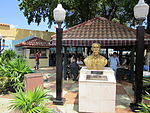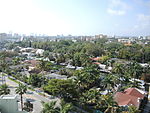2013 World Baseball Classic Pool 2
Pool 2 of the Second Round of the 2013 World Baseball Classic was held at Marlins Park, Miami, Florida, United States from March 12 to 16, 2013. Pool 2 was a modified double-elimination tournament. The losers of the first two preliminary games (Games 1 and 2) matched up in a third preliminary game (Game 3), which was also an elimination game, while the winners of Games 1 and 2 faced each other in the first of two qualifier games (Game 4). The winner of the elimination game then played the loser of the non-elimination game in the second qualifier game (Game 5), which was another elimination game. The remaining two teams then played each other (in Game 6), to determine seeding for the semifinals of the championship round.
Excerpt from the Wikipedia article 2013 World Baseball Classic Pool 2 (License: CC BY-SA 3.0, Authors).2013 World Baseball Classic Pool 2
Northwest 6th Street, Miami
Geographical coordinates (GPS) Address Nearby Places Show on map
Geographical coordinates (GPS)
| Latitude | Longitude |
|---|---|
| N 25.778 ° | E -80.219777777778 ° |
Address
loanDepot park
Northwest 6th Street
33125 Miami
Florida, United States
Open on Google Maps





